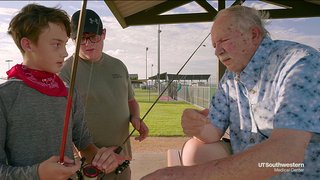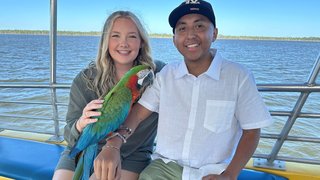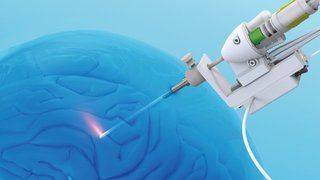Deep venous arterialization saved Irma's foot, and kept her dancing
March 5, 2024

For a long and painful year, Irma Villarreal hobbled around on the heel of her foot. It was the only way she could get around. Gangrene had set into her big toe and second toe after she jammed them into the metal frame of a door in her home, and medication just wasn’t working.
Doctor after doctor insisted Irma’s only option was amputation. Poor circulation and peripheral artery disease (PAD) had created a condition referred to as “desert foot,” which can occur when cholesterol buildup blocks arteries in the lower extremities and dries up blood flow. The result is intense pain, chronic wounds, and tissue death.
Irma feared she’d lose her foot and never walk again, let alone dance – one of her favorite pastimes. Then, a Parkland Hospital nurse clued her in to a new and little-known procedure called deep venous arterialization (DVA).
DVA revitalizes circulation in the foot by creating a new blood flow connection between a healthy artery in the calf or ankle and a vein in the foot. In many cases, new blood vessels grow to support the replenished flow. UT Southwestern is the only medical center offering DVA in North Texas, and I work in partnership with plastic surgeon and podiatric wound care expert Larry Lavery, D.P.M., who shares a clinical space with me in the Limb Salvage program at William P. Clements Jr. University Hospital.

We performed Irma’s DVA procedure in May 2023, and within a few weeks she had regained the ability to walk without pain. Even better, she was able to dance at her sister’s 50th wedding anniversary later that year.
“I had burning in my feet that felt like walking on coals and getting stabbed with needles, all at the same time,” Irma said during a recent interview. “Amputation really horrified me. But when Dr. Siah and Dr. Lavery told me they could save my foot, it was the happiest day ever!
“Now, every time I see them and the staff, I hug them." Irma added. "They are like guardian angels.”
Who can benefit from a DVA procedure?
PAD affects millions of people in the U.S. and is often associated with diabetes and kidney disease. This form of atherosclerosis (hardening of the arteries) in the limbs has a steeper rate of death than most cancers, at 55%-65% in five years without advanced treatment.
“I had burning in my feet that felt like walking on coals and getting stabbed with needles, all at the same time. Amputation really horrified me. But when Dr. Siah and Dr. Lavery told me they could save my foot, it was the happiest day ever! Now, every time I see them and the staff, I hug them. They are like guardian angels.”
Irma Villareal
Still, patients and providers often don’t realize how serious PAD can be and how quickly a minor foot injury can escalate to a life-threatening infection.
If PAD is caught early, placing stents, which are small devices that widen blood vessels, can promote circulation and relieve pain. But for the 14%-20% of patients with desert feet, stenting isn’t enough to restore blood flow. We’ve seen an increase in severe cases over the past two decades, as patients are living longer with kidney disease and diabetes has become more common.
Before DVA, these were designated as “no option” cases, meaning amputation was the only chance to save the patient's life. However, amputation for PAD has up to a 40% mortality rate within a year and is unlikely to improve quality of life in patients who survive.
Today, we can offer DVA to reduce pain, improve function, and restore valuable quality of life – being able to live at home, go to the mailbox, and sleep at night without waking up in pain.
By the time most patients with desert feet get to us, they’ve had two or more doctors say amputation is their only option. So, it is very meaningful when we can tell them DVA might save their foot and give them a chance at a longer, higher-quality life.
What happens in a DVA procedure?
Every patient needs a preoperative angiogram to identify whether they need a DVA as opposed to a conventional stent procedure of the arteries in their calf or ankle. Dr. Lavery and I review the imaging and take an ultrasound to identify healthy blood vessels in the calf, ankle, and foot.

Arteries carry oxygen-rich blood into the foot and veins carry deoxygenated blood back to the heart. DVA is a vascular surgery that essentially turns a vein into an artery. We connect an artery in the calf or ankle to a vein in the foot, disrupting the existing venous structure to support delivery of oxygenated blood, revitalizing the tissues of the foot.
The DVA procedure is minimally invasive with no incisions – just two needle insertions, one in the foot and one in the groin to access the blood vessels. We insert a thin tube called a catheter and guide miniature surgical instruments through it to perform the delicate procedure.
We use the FDA-approved LimFlow™ System, which was designed specifically for these procedures. In 2023, I was the first surgeon in the U.S. to do a commercial case with the LimFlow System.
DVA takes about two hours, and most patients go home one to two days after surgery. Healthy blood flow should increase during two to four weeks following surgery, and over time the body will build new arteries that support oxygenated blood flow.
What is recovery like?
Committing to a post-operative recovery plan with a dedicated physical medicine and rehabilitation team is key to any successful limb-salvage procedure. But unlike typical stenting cases with a one-month follow up, we see patients every other week after DVA because so much can change quickly in the foot.
For example, the influx of oxygen can lead to a serious infection because bacteria living on the wound suddenly have nutrients to thrive. Swelling or further injury of a wound may result in an emergency room visit, and DVA is such a new procedure that most emergency room providers have not seen its healing stages. They may even recommend amputation without context from our care team, which is why I make sure each patient and a family member know that I am always available to them via cell phone.
During the two- to three-month recovery period, Dr. Lavery’s team will tend to the healing diabetic foot ulcers and other foot wounds, clearing dead tissue and covering the area with a skin substitute. Our patients have access to the latest wound-healing therapies, such as negative pressure wound therapy and ultrasound debridement to reduce harmful bacteria.
In follow-up visits, we listen to the new blood vessel connection with ultrasound. Hiccups in the flow may indicate a blockage. Excessive pain or swelling may indicate that too much blood is flowing, which can be corrected with another procedure.
“With my in-home rehabilitation, I learned how to walk the right way again after a year of hobbling around," said Irma. "I did exercises at home to strengthen my muscles and get back on my feet. And it worked, because I was able to do the twist at my sister’s 50th wedding anniversary party!”
Clinical trials for patients with PAD
The makers of LimFlow System sponsored a clinical trial series starting internationally in 2022. Data from the second study, the PROMISE II clinical trial, were published in the New England Journal of Medicine and showed encouraging results. About 66% of the carefully selected participants avoided amputation up to six months after a procedure, exceeding the expected threshold of 54%.
UT Southwestern is currently enrolling patients in the PROMISE III clinical trial, which will introduce DVA as a treatment option to more patients and gather data to refine the procedure and further understand its benefits. Patients who are not eligible for the clinical trial may still be candidates for a DVA procedure.
If you or a loved one has been told that amputation is the only option for a chronic wound associated with PAD, don’t give up hope. At UT Southwestern, we have a whole team of well-trained surgeons who are ready to treat the most challenging limb salvage cases with state of the art technology and techniques.
DVA may not be able to cure peripheral artery disease, but Irma's story is proof it can reduce pain, improve mobility, and help you lead a longer and better life.
To talk with a limb salvage expert, call 214-645-8300 or request an appointment online.











